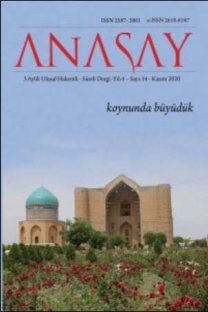GELENEKSEL KOOPERATİF YAPISININ KURUMSAL YÖNETİM AÇISINDAN İNCELENMESİ
kooperatif, kurumsal yönetim, kurumsal yönetim mekanizmaları, temsilcilik teorisi, sahiplik yapısı
GEOGRAPHICAL DETERMINATIONS ABOUT WHAT NEEDS TO BE DONE AT THE POINT OF BRINGING THE ÇOMAKLI MOUNTAIN (MANİSA) TO SUSTAINABLE TOURISM
___
- KAYNAKÇA Babatunde, M. A., & Olaniran, O. (2009). The effects of internal and external mechanism on governance and performance of corporate firms in Nigeria. Corporate ownership & control, 7(2), 330-344.
- Bai, C. E., Liu, Q., Lu, J., Song, F. M., & Zhang, J. (2004). Corporate governance and market valuation in China. Journal of comparative economics, 32(4), 599-616.
- Bijman, J., Hendrikse, G., & Van Oijen, A. (2013). Accommodating two worlds in one organisation: changing board models in agricultural cooperatives. Managerial and decision economics, 34(3-5), 204-217.
- Braendle, U., & Noll, J. (2005). On The Convergence of National Corporate Governance System,10 Mayıs 2022 tarihinde http://papers.ssrn.com/sol3/papers.cfm?abstract_id=506522 adresinden erişildi.
- Brown, P., Beekes, W., & Verhoeven, P. (2011). Corporate governance, accounting and finance: A review. Accounting & finance, 51(1), 96-172.
- Chaddad, F., & Iliopoulos, C. (2013). Control rights, governance, and the costs of ownership in agricultural cooperatives. Agribusiness, 29(1), 3-22.
- Cook, M. L., & Chaddad, F. R. (2004). Redesigning cooperative boundaries: The emergence of new models. American Journal of Agricultural Economics, 86(5), 1249-1253.
- Cook, M. L. (1995). The future of US agricultural cooperatives: A neo-institutional approach. American journal of agricultural economics, 77(5), 1153-1159.
- De Jonghe, O., Disli, M., & Schoors, K. (2012). Corporate governance, opaque bank activities, and risk/return efficiency: pre-and post-crisis evidence from Turkey. Journal of Financial Services Research, 41(1), 51-80.
- Eisenhardt, K. M. (1989). Agency theory: An assessment and review. Academy of management review, 14(1), 57-74.
- Fama, E. F., & Jensen, M. C. (1983). Separation of ownership and control. The journal of law and Economics, 26(2), 301-325.
- Florackis, C. (2008). Agency costs and corporate governance mechanisms: Evidence for UK firms. International Journal of Managerial Finance.
- Hansmann, H. (2013). All firms are cooperatives–and so are governments. Journal of entrepreneurial and organizational diversity, 2(2), 1-10.
- Jensen, M. C., & Meckling, W. H. (1976). Theory of the firm: Managerial behavior, agency costs and ownership structure. Journal of financial economics, 3(4), 305-360.
- Kalkan, G. (2020). Kooperatiflerde Kurumsal Yönetim, F.S. Öngel ve U.D. Yıldırım (Ed.) Krize Karşı KOOPERATİFLER Deneyimler, Tartışmalar, Alternatifler, (ss.349-379). İstanbul: Notabene Yayınları, 2. Baskı.
- Kalkan, G. (2022). Geleneksel Kooperatiflerin Kendine Özgü Doğasından Kaynaklanan Sorunlar ve Bu Sorunların Çözüm Yolları, S.Y Kandır ve İ.D. Ülbeği (Ed.) Güncel İşletme Yönetimi Çalışmaları II, (ss.93-107). Ankara: Akademisyen Yayınevi.
- Nilsson, J. (1999). Co-operative organisational models as reflections of the business environments. LTA, 4(99), 449-470.
- Prowse, S. (1995). Alternative methods of corporate control in commercial banks (No. 9507). Federal Reserve Bank of Dallas.
- Shleifer, A., & Vishny, R. W. (1997). A survey of corporate governance. The journal of finance, 52(2), 737-783.
- Weimer, J., & Pape, J. (1999). A taxonomy of systems of corporate governance. Corporate governance: An international review, 7(2), 152-166.
- ISSN: 2587-2001
- Yayın Aralığı: Yılda 4 Sayı
- Başlangıç: 2017
- Yayıncı: İshak KÜÇÜKYILDIZ
SİNEMADA ASPERGER SENDROMU BAĞLAMINDA BENİM ADIM KHAN FİLMİNİN DEĞERLENDİRİLMESİ
Pınar ÖZTARKAN ÖZYURT, Ala SİVAS GÜLÇUR
OKULÖNCESİ ÖĞRENCİLERİNDE AFET YÖNETİMİNE DAİR BİR GÖZLEM: IĞDIR’DA BİR İLKOKUL ÖRNEĞİ
Z KUŞAĞININ KÜLTÜREL MİRAS ALGISI: SAFRANBOLU ÖRNEĞİ
ORTA ASYA’DA ERKEN İSLÂMİ DÖNEM MEZAR TAŞLARI
SİYASÎ EVLİLİKLER BAĞLAMINDA MOĞOL DIŞ POLİTİKASI VE KADIN
DEMOKRAT PARTİ DÖNEMİ TÜRKİYE-BULGARİSTAN İLİŞKİLERİ (1950-1960)
KARALAMA DEFTERİNDEN KENDİ METNİNE DOĞRU YAZARLIK UĞRAŞISINA BAKIŞ
